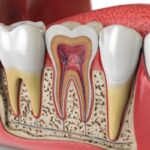Endodontics refers to the diagnosis and treatment of issues related to the dental pulp inside of a tooth’s root. The dental pulp may become damaged after tooth decay, dental trauma, or other concerns leave the root of the tooth exposed. This article goes over the situations in which endodontics treatment may be necessary.
A guide to the purpose of endodontics treatment in dentistry
Endodontic treatment is generally more complex than the typical dental procedure. Consequently, it is only performed when doing so is necessary to save the long-term health of a damaged tooth. It is helpful to understand when and why your dentist may recommend endodontic treatment and what the treatment procedure involves.
What is endodontics treatment?
The most common endodontic procedure is root canal therapy. This procedure treats the infected pulp inside of the tooth’s root to save the tooth from becoming lost or leading to other complex concerns such as the spread of an oral infection.
When is endodontic treatment recommended?
As mentioned, endodontics involves treating issues with dental pulp, which is inside of the pulp chamber in the root of the tooth. Specifically, endodontic treatment deals with infected, decayed, or damaged dental pulp. This can occur when the root of the tooth is exposed due to deep tooth decay, dental trauma (e.g., a chip or a crack), or an oral infection.
While this is the primary reason for endodontic treatment, there may be other times when a dentist may recommend endodontics, as well.
What can I expect during endodontic treatment?
As described above, the main endodontics procedure is root canal therapy. This procedure involves accessing the tooth’s pulp chamber, which will require drilling toward the root of the tooth.
The tooth is cleaned and the infected, damaged, or decayed portion of the tooth is then removed and filled with a material known as gutta-percha. After the procedure, a dental crown is typically placed to restore the size and shape of the tooth and to protect it from further harm.
What is the recovery process like?
Endodontic treatment is more invasive than dental procedures such as dental fillings, and it may take several days for patients to make a full recovery.
During the recovery process, patients are encouraged to keep their mouth clean through good oral hygiene and avoid the consumption of foods and drinks that could increase the risk of infection, such as those that contain a lot of sugar. After the patient makes a full recovery, the focus is on the prevention of future endodontic concerns through regular check-ups and cleaning visits and a good at-home oral hygiene routine.







Leave a Reply